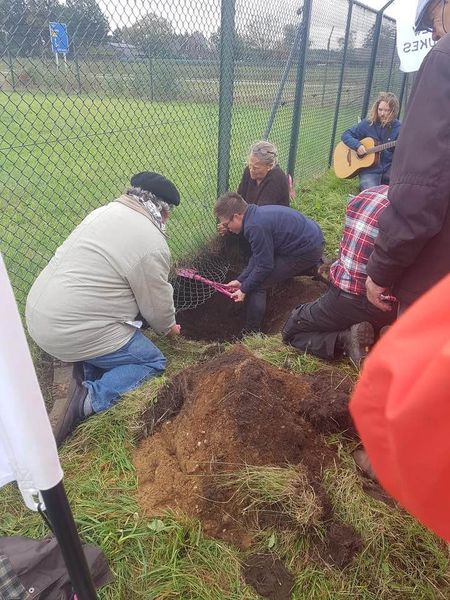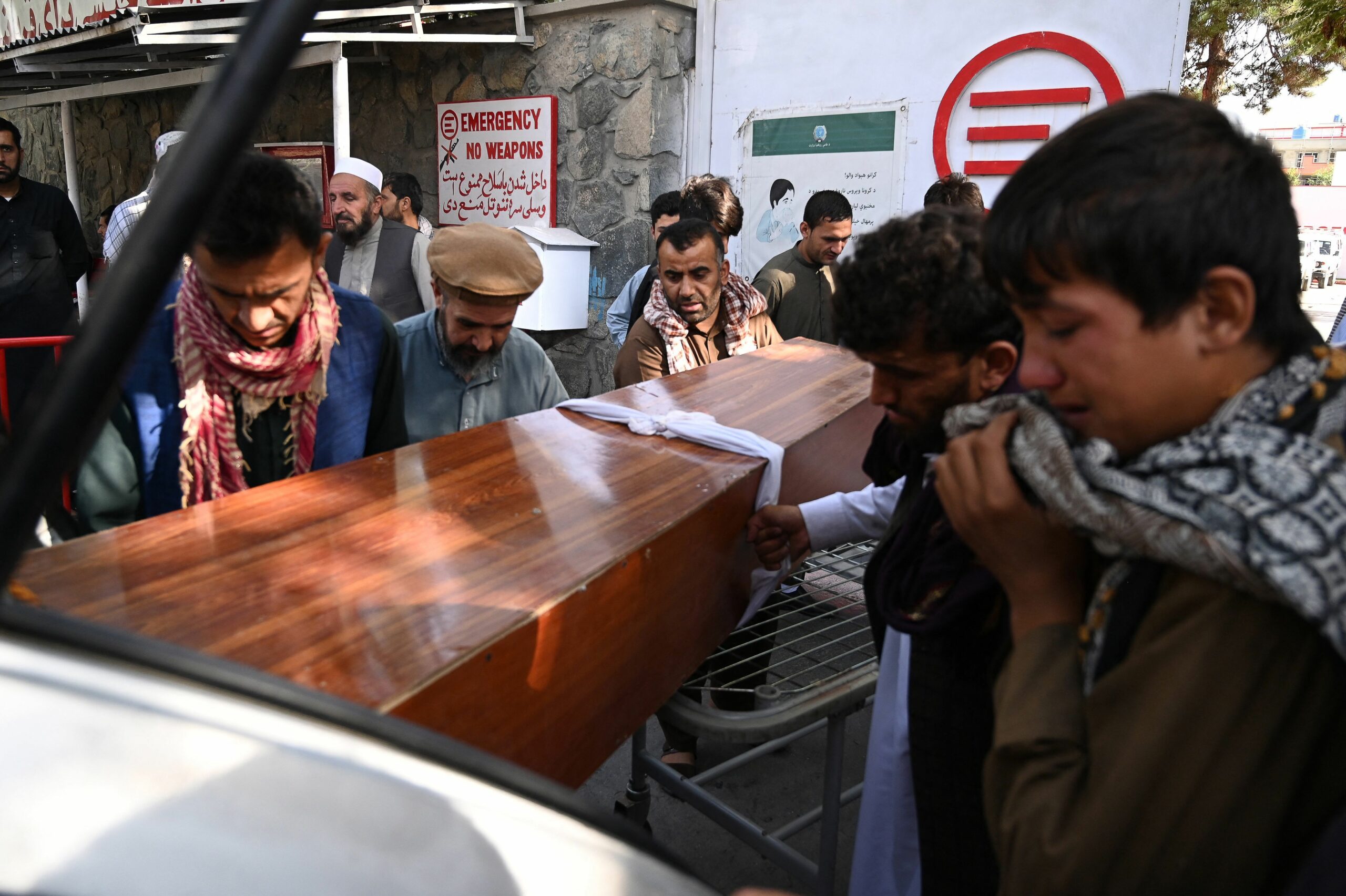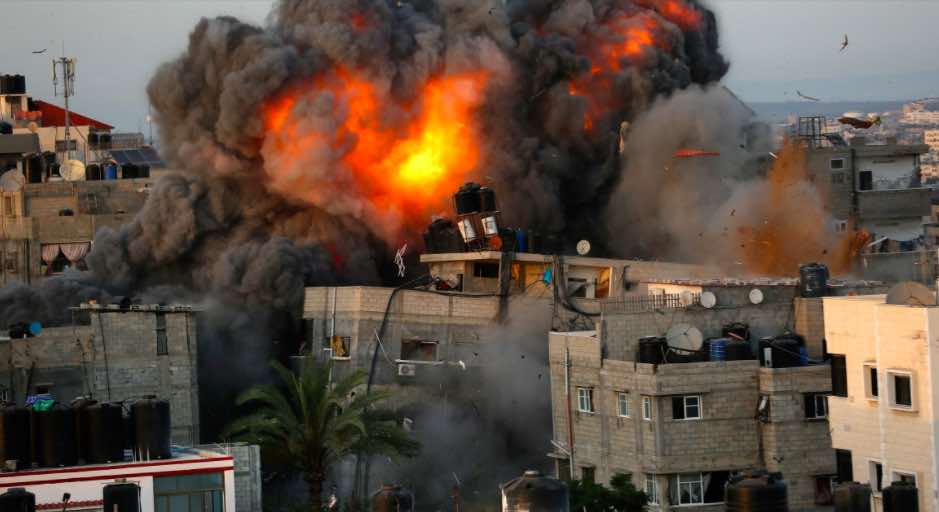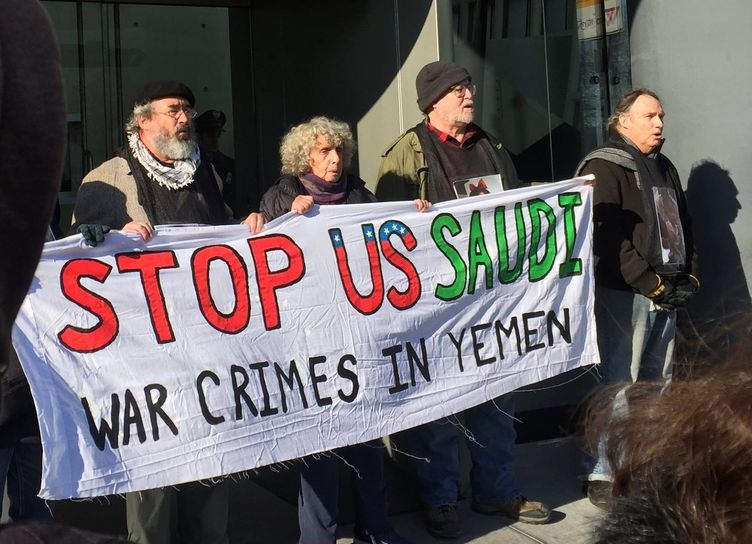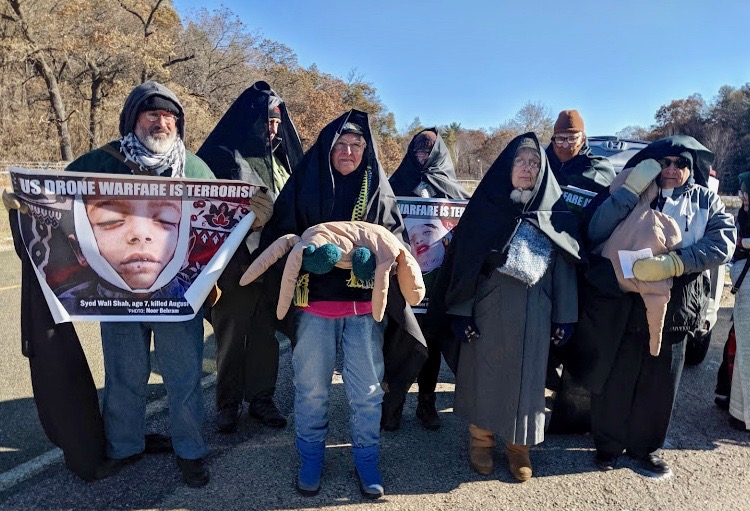Am 13. Mai 2013 hielt Präsident Obama vor der National Defense University (Nationale Verteidigungsuniversität) eine längere Rede zum Thema “Über die Zukunft unseres Kampfes gegen den Terrorismus”, in der er zum ersten Mal über das offiziell noch immer geheime Programm der US-Regierung der gezielten Attentate durch ferngesteuerte Drohnen sprach. Ich war in der Lage, diese Rede im Fernsehen aus dem privilegierten Blickwinkel des Insassen eines Bundesgefängnisses zu verfolgen, am letzten Tag einer Haftstrafe aufgrund meines Protests gegen Kampfdrohnen, die von der Whiteman Luftwaffen-Basis in Missouri aus in mehreren Ländern in der ganzen Welt tödlich eingesetzt werden.
In den vorhergehenden sechs Monaten im Bundesgefängnis von Yankton, South Dakota, hatte ich aus der Ferne beobachtet, wie die Diskussion um die Kriegsführung mit Drohnen von einem randständigen zu einem zentralen Thema wurde. Mitgefangene brachten mir Zeitungsausschnitte zum Thema aus ihren heimatlichen Lokalzeitungen und berichteten mir, was sie in den Abendnachrichten gehört hatten. Es schien, dass das amerikanische Volk gerade erst anfing, die Realität und die Konsequenzen von Kriegen und Attentaten wahrzunehmen, die von unbemannten, aber schwerbewaffneten Flugkörpern ausgeführt werden, gesteuert am Computerbildschirm von Kombattanten, die weit entfernt vom Konfliktherd in heimischen Militärbasen sitzen.
Mein eigener Anti-Drohnen-Aktivismust begann im April 2009 mit Protesten an der Creech-Luftwaffenbasis in der Wüste von Nevada. Damals waren selbst ansonsten gut informierte Leute skeptisch, ob so etwas überhaupt möglich sei, geschweige denn sich täglich ereignete. Viele, die davon wussten, akzeptierten die simple und gute Mär von der Kriegsführung mit Drohnen als präzises neuartiges High-Tech-Systems, mit Hilfe dessen Soldaten aus sicherer Entfernung von Tausenden von Meilen diejenigen, die uns unmittelbar bedrohen, mit nur geringen oder ganz ohne Kollateralschäden festnageln können.
Selbst einige unserer Freunde aus der Friedensbewegung zweifelten daran, ob es klug sei, die Aufmerksamkeit auf die Drohnen zu lenken. Müssen wir gegen jeden Fortschritt in der Waffentechnologie protestieren? Können wir nicht Methoden tolerieren, die unterschiedsloses Töten zumindestens verringern? Ist die präzis geplante und ausgeführte Drohnenattacke nicht der Flächen-Bombardierung vorzuziehen? Oder der Invasion? Macht es für die Opfer in jedem Fall einen Unterschied, ob sich an Bord des Flugzeugs, das sie bombardiert, ein Pilot befindet oder nicht?
Die Tatsache, dass vier Jahre später, am Tag vor meiner Entlassung aus dem Gefängnis, der Präsident der Vereinigten Staaten den Einsatz von Drohnen vor dem Land und der Welt rechtfertigt, ist wahrhaft bemerkenswert. Es ist keine Diskussion, die er oder irgendjemand anderes in der Regierung, der Politik oder im Militär angeregt oder auf die die Medien sehnlichst gewartet hätten. Die Tatsache, dass das Thema überhaupt öffentlich diskutiert wird, verdanken wir allein dem bemerkenswerten Einsatz weniger Menschen hier in den USA und in Großbritannien, die in Solidarität mit vielen auf den Straßen Pakistans, Jemens und Afghanistans gegen dieses schmutzige Waffensystem protestiert haben. Gemeinschaften des Protests und Widerstands in Nevada, New York, Kalifornien, Missouri, Wisconsin, Iowa und England haben das Thema durch kreative Aktionen und juristische Strategien in lokale Foren, Gerichte und Medien gebracht und erfolgreich gefordert, dass das durch Drohnentötungen verursachte Leid wahrgenommen wird. Die Rede des Präsidenten selbst wurde nur durch die Störung unserer Freundin Medea Benjamin davor bewahrt, die schlau konstruierte aber leere Litanei aus Alibi, Halb-Wahrheit und Verschleierung zu werden, als die sie geplant war.
In seinem “Brief aus dem Gefängnis in Birmingham”* aus dem Jahr 1963 bemerkte Dr. Martin Luther King jr., eine Gesellschaft wie unsere sei oftmals “in dem unheilvollen Versuch stecken geblieben, im Monolog zu leben statt im Dialog” und erfordere “gewaltloses Handeln”, um “eine Spannung im Geist hervorzurufen, damit sich der Mensch aus der knechtischen Abhängigkeit von Mythen und Halbwahrheiten in das freie Reich schöpferischer Analyse und objektiver Bestimmung der Werte erheben” kann.
Genau wie bei der Frage der Rassentrennung vor 50 Jahren kann heute innerhalb des Diskussionsrahmens, der durch Höflichkeit und gute Manieren bestimmt oder durch Polizei und Gerichte sanktioniert wird, die objektive Bewertung von Drohnen-Kriegsführung schlicht und einfach nicht geleistet werden. Die gegenwärtige Debatte wird nur durch einige wenige möglich gemacht, die es so wie Medea wagen, sich ungefragt zu äußern oder die ihre Körper einsetzen, um das ordnungsgemäße Ausüben von Verbrechen in unserer Mitte zu verhindern. Vor der Rede des Präsidenten gab es in Umfragen die höchste Zustimmung zur Kriegsführung mit Drohnen, aber schon einen Monat später bemerkte der Drohnenpilot Colonel Bryan Davis von der Luftwaffen-Nationalgarde in Ohio einen Stimmungsumschwung. “In der amerikanischen Öffentlichkeit sind wir nicht populär. An jeder anderen Basis wurde protestiert”, beklagte er sich in einer Lokalzeitung. “Für uns ist das kein warmes Gefühl.”
Die Mär von der humanitären Kriegsführung durch Drohnen hatte in der öffentlichen Meinung in den Wochen vor der Rede des Präsidenten angefangen zu bröckeln und hat seither weiter an Reputation verloren. Schon Monate bevor der Präsident behauptete, “indem wir unsere Aktion präzise auf jene richten, die uns töten wollen, und nicht auf die Menschen, unter denen sie sich verstecken wählen wir ein Vorgehen, das am unwahrscheinlichsten zum Verlust unschuldiger Leben führt”, hatte seine Administration frühere Behauptungen korrigiert, bei den Drohnen-Programmen in Jemen und Pakistan wären keine bekannten zivilen Opfer bekannt geworden – dann hieß es, es gebe einen Todesfall, schließlich gab man eine Todesrate im “einstelligen Bereich” zu. Fast jede Zählung ergab aber zivile Opfer in mindestens dreistelliger Höhe.
Nur wenige Wochen nachdem der Präsident vor der National Defense University gesprochen hatte, veröffentlichte eine Zeitschrift dieser Institution eine Studie, die seine Versicherung, dass “konventionelle Luftwaffen und Raketen weniger präzise als Drohnen sind und wesentlich mehr zivile Opfer und lokale Empörung erzeugen”, widerlegte. Drohnenangriffe in Afghanistan, befand die Studie, gibt es “in einer Größenordnung, die zivile Opfer bei jedem Einsatz wahrscheinlicher macht.”
Eine weitere Zusicherung seiner Rede, Amerika könne “nicht zuschlagen, wo immer wir wollen; unsere Aktionen sind durch Konsultationen mit Partnern und den Respekt vor der Souveränität der Staaten begrenzt”, wurde am 8. Juni widerlegt, als der US-Botschafter in Pakistan vom wütenden Premierminister des Landes bestellt wurde, weil ein US-Drohnenangriff neun Menschen getötet hatte. “Dem US-Chargé d’ Affaires wurde mitgeteilt, dass die Regierung Pakistans die Drohnenangriffe, die eine Verletzung der Souveränität und territorialen Integrität Pakistans darstellen, scharf verurteilt”, so der pakistanische Außenminister. “Die Wichtigkeit wurde betont, die Drohnenangriffe unverzüglich zu beenden.”
“Wir agieren gegen Terroristen, die eine andauernde und unmittelbare Bedrohung des amerikanischen Volkes darstellen.” Früher bezog sich das Wort “unmittelbar” auf etwas, das jeden Augenblick geschehen kann, und der Gebrauch der allgemeingültigen Definition des Wortes könnte mit den Worten des Präsidenten die Garantie bedeuten, Drohnenangriffe würden nur ausgeführt, um “Terroristen” aufzuhalten, die gerade im Begriff wären, Amerikanern unmittelbares Leid zuzufügen. Im September 2011 schlug John Brennan, jetzt CIA-Direktor, vor, dass “ein flexibleres Verständnis von ‘Unmittelbarkeit’ angebracht sein kann, wenn man es mit terroristischen Gruppen zu tun hat”. Dieses flexiblere Verständnis von “Unmittelbarkeit” rechtfertigt die Tötung nicht nur von denen, die bei der Ausübung der Tat ertappt wurden, sondern zielt auch auf jene, die verdächtigt werden, irgendetwas geschrieben oder gesagt zu haben, was irgendjemanden dazu bringen könnte, irgendwann irgendetwas mit einem Angriff auf die USA zu tun zu haben. Eine Person, die von einem Drohnen-Überwachungsvideo aus 7000 Meilen Entfernung erfasst wird, weil sie auf eine Art und Weise handelt, die jemandem ähnelt, der vielleicht eines Tages Gewalt ausüben könnte, kann jetzt als unmittelbare Bedrohung eliminiert werden.
In Hinsicht auf die Tötung Anwar Awlakis, eines US-Bürgers im Jemen, versicherte uns der Präsident: “Offiziell gesagt, ich glaube nicht, dass es in Übereinstimmung mit der Verfassung ist, wenn die Regierung irgendeinen US-Bürger ohne ordentliches Verfahren verfolgt und tötet – ob mit einer Drohne oder einem Gewehr.” Der generelle Gebrauch des Ausdrucks “ordentliches Verfahren” erzeugt die falsche Vorstellung, hier würde das Recht des Bürgers auf ein Gerichtsverfahren vor der Exekution zugesichert. “Dies ist schlicht nicht korrekt”, so Generalbundesanwalt Eric Holder. “‘Ordentliches Verfahren’ und ‘Gerichtsverfahren’ sind nicht dasselbe, besonders nicht, wenn es um die nationale Sicherheit geht. Die Verfassung garantiert ein ordentliches Verfahren, kein Gerichtsverfahren.” Von einem “ordentlichen Verfahren” kann nun gesprochen werden, wenn der Präsident aufgrund geheimer Beweismittel entscheidet, dass ein Bürger sterben soll.
Die Drohnentechnologie verändert unsere Sprache über eine Neudefinierung von Ausdrücken wie “Unmittelbarkeit” und “ordentliches Verfahren” hinaus. Indem wir eine interkontinentale Atomwaffe “Peacekeeper” genannt haben, sind wir schon über Orwellsche Euphemismen hinausgegangen. Diese neuen “hunter-killer”-Plattformen (Jäger-Mörder-Plattformen) tragen Namen wie “Predators” (Raubtiere) oder “Reapers” (Sensenmänner) und werden wohl bald von “Avengers” (Rächern) und “Stalkers” (Pirscher) verdrängt werden. Die Botschaft, die sie überbringen, ist eine Rakete namens “Hellfire” (Höllenfeuer).
In Iowa, wo ich lebe, hat die in Des Moines stationierte Einheit der Nationalgarde ihre F-16-Jagdbomber durch ein Kontrollzentrum für Reaper-Drohnen ersetzt. Diese Veränderung wurde begleitet von der Umwandlung des Namens von “132nd Fighter Wing” (132. Kampf-Flügel) zu “132nd Attack Wing” (132. Angriffs-Flügel). Dieser Wandel ist mehr als symbolisch – ein “Kampf” hat per Definition zwei Seiten, und das Wort umfasst irgendeine Art von Gleichwertigkeit. Es gibt so etwas wie einen fairen Kampf (aber natürlich wurden die F-16-Bomber des 132. Flügels nur gegen wehrlose Zivilbevölkerung an Orten wie Irak und Panama eingesetzt), und ein Kampf hat normalerweise eine Art von Lösung. Ein “Angriff” jedoch ist eben nur das. Ein Angriff ist einseitig, etwas, das der Verfolger dem Opfer zufügt. Ein Kampf mag manchmal gerechtfertigt sein, ein Angriff nie. Es gibt keine Theorie des “gerechten Angriffs”. Das Aussortieren von unschuldigen und schuldigen Drohnenopfern ist sozusagen eine Zeitvergeudung. Alle sind gleichermaßen Opfer.
Vielleicht hat George Kennan dies in einem Strategiepapier, das er 1948 für das Außenministerium verfasste, kommen sehen. Um die unterschiedliche globale Verteilung des Reichtums nach dem Zweiten Weltkrieg zu bewahren (“Wir besitzen etwa 50 Prozent des Reichtums der Welt, aber nur 6,3 Prozent der Bevölkerung”) schlug er vor, “wir sollten aufhören, über vage und irreale Themen wie wie Menschenrechte, die Verbesserung des Lebensstandards und Demokratisierung zu sprechen. Der Tag ist nicht fern, an dem wir mit klaren Machtkonzepten operieren müssen. Je weniger wir dann von idealistischen Slogans behindert werden, desto besser.” Die Rede vor der National Defense University stellte eine Peinlichkeit an idealistischen Slogans dar, befasste sich aber auch mit kühlem Pragmatismus mit klaren Machtkonzepten.
“Mich und alle, die meiner Befehlskette angehören,”, so der Präsident am 23. Mai, “werden diese Todesopfer für den Rest unseres Lebens verfolgen.” Diese Worte klangen einige Tage später ehrlicher, als sie in den Fernsehnachrichten des Senders NBC von Brandon Bryant ausgesprochen wurden, ein Drohnen-Operateur der Luftwaffe, der gestand, von den 1600 Todesfällen, an denen er beteiligt war, verfolgt zu werden. Bryant gestand, seine Aktionen bewirkten, dass er sich als “herzloser Soziopath” fühle, und er beschrieb eine seiner ersten Tötungen, als er in der Creech-Luftwaffenbasis in Nevada saß, während sein Team auf drei Männer feuerte, die eine Straße in Afghanistan entlang gingen. Dort war es Nacht, und er erinnerte sich, wie er das Thermalbild eines der Opfer auf seinem Computer-Bildschirm erblickte: “Ich beobachtete, wie dieser Typ verblutete, und, ich meine, Blut ist heiss.” Bryant beobachtete, wie der Mann starb und sein Bild verschwand, während der Körper die Temperatur des Erdbodens der Umgebung annahm. “Ich kann jedes kleine Pixel sehen, ich schließe einfach meine Augen.” Die Entfernung des Drohnenkriegers ist kein Schutz vor der moralischen Zerstörung des Krieges, und auch dies sind Opfer, in deren Namen wir ebenfalls protestieren.
Wir können nicht in die Herzen des Präsidenten und jener in seinem inneren Kreis blicken, aber es fällt nicht schwer daran zu zweifeln, dass sie sich wirklich vom Tod der Menschen, die auf ihren Befehl hin von Drohnen getötet wurden, verfolgt fühlen. Wenn sie nicht von ihrem eigenen Gewissen verfolgt werden, fällt vielleicht uns die Verantwortung zu, sie zu verfolgen.
* zitiert nach: Die Zeit für schöpferischen Protest ist gekommen. Der Brief aus dem Gefängnis in Birmingham, in: King, Martin Luther, Schöpferischer Widerstand, hrsg. von Heinrich W. Grosse, Gütersloh 1985, übersetzt von Ruth Rostock und Alfred Schmidt
On May 23, 2013, President Obama gave a major address from the National Defense University, ON THE FUTURE OF OUR FIGHT AGAINST TERRORISM, in which he acknowledged for the first time the US government’s still officially secret program of assassination by remotely controlled drones. I was able to watch this televised speech from the privileged vantage of a federal prison on the last day of a sentence resulting from my protest of drones lethally operated from Whiteman Air Force Base in Missouri over various countries around the world.
Over the previous six months in the Federal Prison Camp at Yankton, South Dakota, I had watched from afar as the discussion on drone warfare emerged from the fringe and into the mainstream. Fellow prisoners brought me clippings on the subject from their local newspapers and kept me apprised of what they heard on the evening news. The American people seemed to be just awakening to the reality and consequences of wars being and fought and assassinations carried out by unmanned but heavily armed planes controlled by combatants sitting at computer screens at stateside bases far from the conflict.
My own anti-drone activism began with protests at Creech Air Force Base in the Nevada desert in April, 2009. Even some otherwise well informed people were skeptical, back then, that such things were even possible, much less happening daily. Many who were aware accepted the simple and happy narrative of drone warfare as a precise new high-tech system in which soldiers from a safe distance of thousands of miles can pin point those who mean us imminent harm with little or no collateral damage.
Even some among our friends in the peace movement questioned the wisdom of focusing attention on drones. Must we protest every new advance in weaponry? Can’t we allow for methods that are at least improvements on indiscriminate carnage? Is not a precisely aimed and delivered drone attack preferable to carpet bombing? Is it not preferable to invasion? Does it make a difference to the victims, in any case, whether there is a pilot in the plane that bombs them or not?
The fact that four years later on the day before my release from prison, the president of the United States was defending the use of drones before the country and the world is truly remarkable. This is not a discussion that he or anyone else in the government, politics or the military encouraged or one that the media was anxious to take on. The fact that the issue is up for discussion at all is due to considerable efforts of the few here in the US and the UK in solidarity with many in the streets in Pakistan, Yemen and Afghanistan protesting this foul weaponry. Communities of protest and resistance in Nevada, New York, California, Missouri, Wisconsin, England and Iowa thrust the issue into local forums, courts and media through creative actions and legal stratagems, effectively demanding that grievance over drone killing be heard. The president’s own speech was itself only rescued from being the cleverly constructed but empty litany of alibi, half-truth and obfuscation that it was intended to be by the interruption by our friend, Medea Benjamin.
In his 1963 “Letter from a Birmingham Jail,” Dr. Martin Luther King, Jr., noted that often a society like ours “bogged down in the tragic attempt to live in monologue rather than dialogue,” requires “nonviolent gadflies” in order to “create a tension in the mind so that individuals could rise from the bondage of myths and half-truths to the unfettered realm of creative analysis and objective appraisal.”
As with the issue of segregation 50 years ago, so today the parameters of discussion allowed by politeness and good manners or sanctioned by the police and courts simply cannot abide the objective appraisal of drone warfare that the times require. The discussion such as it is, is made possible only by some who dare speak out of turn, as Medea, or who use their bodies to intrude on the orderly commission of criminalities in our midst. Before the president’s lecture drone warfare’s approval rating was at the top of the polls but a month later drone pilot Col. Bryan Davis of the Ohio Air National Guard noted a turn of the tide. “We are not popular among the American public, every other base has been protested,” he lamented to a local paper. “It doesn’t make you feel warm inside.”
The narrative of humanitarian war via drone had begun to unravel in the public eye in the months leading up to the president’ speech and has since fell further into disrepute. Months before the president made the assertion in his May 23 speech that “by narrowly targeting our action against those who want to kill us and not the people they hide among, we are choosing the course of action least likely to result in the loss of innocent life,” his administration had already revised earlier claims that the drone programs in Yemen and Pakistan had yielded zero known noncombatant deaths to one death to finally admit to a death toll in “single digits.” By almost any accounting the noncombatant tolls in those countries have been at least in the hundreds.
Just weeks after the president spoke at the National Defense University, a journal published by that institution published a study that debunked his assurance that “conventional airpower and missiles are far less precise than drones, and likely to cause more civilian casualties and local outrage.” Drone strikes in Afghanistan, the study found, were “an order of magnitude more likely to result in civilian casualties per engagement.”
Another assurance given in this speech, that “America cannot take strikes wherever we choose; our actions are bound by consultations with partners, and respect for state sovereignty,” was discredited on June 8 when the US ambassador to Pakistan was summoned by the prime minister of that country angry over a US drone attack that killed nine people. “It was conveyed to the US chargé ď affaires that the government of Pakistan strongly condemns the drone strikes, which are a violation of Pakistan’s sovereignty and territorial integrity,” said Pakistan’s ministry of foreign affairs. “The importance of bringing an immediate end to drone strikes was emphasized.”
“We act against terrorists who pose a continuing and imminent threat to the American people.” Formerly the word “imminent” referred to something about to happen at any moment and using the generally accepted definition of the word one might construe in the president’s words a guarantee that drone strikes are used only to stop “terrorists” engaged in acts that would cause immediate harm to Americans. John Brennan, now director of the CIA, suggested in September 2011 that “a more flexible understanding of ‘imminence’ may be appropriate when dealing with terrorist groups.” This more flexible understanding of imminence justifies the assassination not only of those caught in the act, but also of targets who are suspected of having written something or said something to make someone think that they might have something to do with an attack on the US someday. A person who is caught on the drones video feed from 7,000 miles away as acting in a manner consistent with someone who might harm one day may now be eliminated as an imminent threat.
Referring to the killing of Anwar Awlaki, an American citizen in Yemen, the president assured us that “for the record, I do not believe it would be constitutional for the government to target and kill any US citizen — with a drone, or with a shotgun — without due process.” The general usage of the words “due process” would cause the misapprehension that the right of a citizen to have trial by jury before being executed is being reaffirmed here. “This is simply not accurate,” says Attorney General Eric Holder. “‘Due process’ and ‘judicial process’ are not one and the same, particularly when it comes to national security. The Constitution guarantees due process, not judicial process.” The burden of “due process” can now be met when the president decides based on secret evidence that a citizen should die.
Drone technology is changing our language beyond redefining terms like “imminence” and “due process.” We have progressed, too, beyond Orwellian euphemisms such as naming an intercontinental nuclear missile “Peacekeeper.” These new “hunter-killer platforms” bear names like “Predators” and “Reapers” and may soon be supplanted by “Avengers” and “Stalkers.” The ordinance they deliver is a missile named “Hellfire.”
In Iowa where I live, the Air National Guard unit based in Des Moines has replaced its F-16 fighter planes with a Reaper drone control center. This transformation was marked by changing the units name from the “132nd Fighter Wing” to the “132nd Attack Wing.” This change is more than symbolic- a “fight” by definition has two sides and the word implies some kind of parity. There is such a thing as a fair fight (of course the 132nd’s F-16s were used only on all but disarmed populations in places like Iraq and Panama) and a fight usually has some kind of resolution. An “attack” however, is just that. An attack is one-sided, something that a perpetrator inflicts on a victim. A fighter might sometimes be justified, an attacker, never. There is no “just attack” theory. The parsing out of innocent and guilty drone victims is in a sense a waste of time. All alike are victims.
George Kennan, might have seen this coming in a policy paper he wrote for the State Department in 1948. In order to preserve the global disparity of wealth post World War II (“We have about 50% of the world’s wealth, but only 6.3% of its population”) he suggested that “we should cease to talk about vague and unreal objectives such as human rights, the raising of the living standards, and democratization. The day is not far off when we are going to have to deal in straight power concepts. The less we are then hampered by idealistic slogans, the better.” While the speech at the National Defense University was an embarrassment of idealistic slogans, it also dealt with straight power concepts with chilling pragmatism.
“For me,” the president said on May 23, “and those in my chain of command, those deaths will haunt us as long as we live.” Those words had a truer ring a few days later spoken on NBC news by Brandon Bryant, an Air Force drone operator who confessed to being haunted by 1,600 deaths he took part in. Bryant admitted that his actions made him feel like a “heartless sociopath,” and he described one of his first kills, sitting in a chair at Creech Air Force Base in Nevada when his team fired on three men walking down a road in Afghanistan. It was night in Afghanistan, and he remembers watching the thermal image of one victim on his computer screen: “I watch this guy bleed out and, I mean, the blood is hot.” Bryant watched the man die and his image disappear as his body attained the ambient temperature of the ground. “I can see every little pixel, if I just close my eyes.” The remoteness of the drone warrior is no protection from the moral damage of war and these are victims as well and it is on their behalf as well that we protest.
We cannot know the hearts of the president and those in his inner circle but it is not hard to wonder whether they are truly haunted by the deaths of those killed by drones at their commands. If they may not be haunted by their own consciences, perhaps the responsibility of haunting them falls to us.




